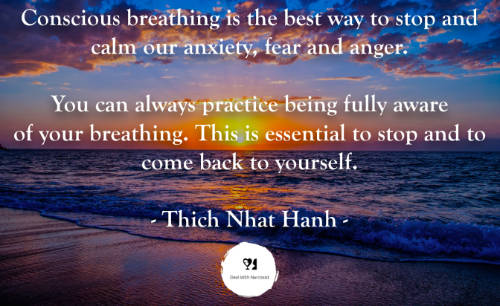When you’re dealing with a narcissist your energy is being drained and you might become (more) disconnected from yourself. It’s a brutal experience and it’s necessary to counterbalance the effects a narcissist has on you and to slowly restore your energy. A great way to do this is by trying to practice conscious breathing.
My view on how to deal with narcissists is to first gain knowledge about narcissism to recognize and analyze their behaviour and then slowly trying to shift the attention back to yourself again. This shift as well as recovering from the influence of a narcissist can require a lot of time and that’s okay. It’s normal it takes time to heal as they can have such a large negative impact on you and your self-worth.
I believe conscious breathing or mindfulness can be a simple, practical and effective method to protect your energy. This article fits in the category of ‘self-worth and your energy’ and is about shifting attention to yourself again. This article is closely related to my more recent article exploring mindfulness and narcissistic abuse.
Conscious breathing focuses on the mental aspect of dealing with narcissists and can be used when still interacting with a narcissist but more importantly after going no contact as well. This is because it’s likely the attention of the mind is still with the narcissist a lot after going no contact.
If you’re still interacting with a narcissist you can read my in-depth article about the grey rock method. This is a method that will help you emotionally detach from a narcissist when having to interact with them. Conscious breathing can help you to stay more sane when needing to use the grey rock method. If you, for example, have a narcissistic boss you could also read this article about how to deal with a narcissistic boss.
Whether you are in contact or no contact, it’s essential to eventually stop giving the narcissist the attention they crave and to start focusing on yourself. You could have been neglecting your own needs and feelings for a long time. You deserve your own kindness and attention and we can start today by giving more attention to your breathing!
How conscious breathing helped me
I grew up with a narcissistic father and eventually when my confidence and self-worth were at rock-bottom I discovered Buddhism. It helped me get through a lot. I have been reading and learning about Buddhism for about a decade now and one of my favorite writers is Thich Nhat Hanh. He is a very kind and compassionate soul. Inspired by one of his books I will go into conscious breathing in this article and I hope this can be helpful to you as well.
If you experience or have experienced a narcissist you know how much impact they can have on yourself. Narcissists can have a negative impact on your self-worth by creating doubts, constantly manipulating and emphasizing negative thoughts or feelings. You could be confused, doubtful and not feeling like yourself anymore. Independent of whether you are still in contact or no contact with a narcissist it’s important to shift attention to yourself and work on restoring your energy.
In a way, I think it’s a powerful method to take a lot of small steps in the right direction. A narcissist pushes you into a negative and destructive direction in which it can seem impossible to stop their control, to recover and/or feel something different again. Conscious breathing can be a small step to becoming yourself again.
I want to emphasize that you don’t need to have any special interest in Buddhism or mindfulness to do these breathing exercises or to do meditation. I will take a practical approach. Conscious breathing is all about having attention for yourself and being aware of your body, feelings, and mind. In my experience, that’s exactly what’s lacking when under the influence of narcissists.
Meditation and breathing exercises have been and still are very helpful to me. Breathing is a miracle. So let’s try to enjoy it!
The Four Establishments of Mindfulness
The basis for conscious breathing is the Sutta on the ‘Four Establishments of Mindfulness’. The breathing exercises can be seen as a foundation for practicing mindfulness. It’s called the Anapanasati Sutta and can be used as a start for going into meditation by being aware of your breathing but also it can be used to simply be more mindful and conscious. The Sutta contains sixteen steps of practice grouped into four establishments (methods of mindfulness).
These establishments are as follows:
1. Body.
2. Feelings.
3. Mind.
4. Objects of the mind.
Below I will show you the full translation of sixteen breathing instructions in the Sutta translated by Thich Nhat Hanh. You can visit this website if you want to read the full translation of the Sutta.
I will show all the full instructions below but I will focus on mainly the first two establishments body and mind which are the first eight exercises. The steps are build up in stages which means you can practice as many stages you want and you can experience if it works for you. I hope you don’t let the full exercise overwhelm or discourage you, as it would be great already if you can practice one or a few of these exercises.
Mindfulness of the Body
1. Breathing in a long breath, I know I am breathing in a long breath.
Breathing out a long breath, I know I am breathing out a long breath.
2. Breathing in a short breath, I know I am breathing in a short breath.
Breathing out a short breath, I know I am breathing out a short breath.
3. Breathing in, I am aware of my whole body.
Breathing out, I am aware of my whole body.
4. Breathing in, I calm my whole body.
Breathing out, I calm my whole body.
Mindfulness of the Feeling
5. Breathing in, I feel joyful.
Breathing out, I feel joyful.
6. Breathing in, I feel happy.
Breathing out, I feel happy.
7. Breathing in, I am aware of my mental formations.
Breathing out, I am aware of my mental formations.
8. Breathing in, I calm my mental formations.
Breathing out, I calm my mental formations.
Mindfulness of the Mind
9. Breathing in, I am aware of my mind.
Breathing out, I am aware of my mind.
10. Breathing in, I make my mind happy.
Breathing out, I make my mind happy.
11. Breathing in, I concentrate my mind.
Breathing out, I concentrate my mind.
12. Breathing in, I liberate my mind.
Breathing out, I liberate my mind.
Mindfulness of the Mental Objects
13. Breathing in, I observe the impermanent nature of all dharmas.
Breathing out, I observe the impermanent nature of all dharmas.
14. Breathing in, I observe the disappearance of desire.
Breathing out, I observe the disappearance of desire.
15. Breathing in, I observe the no-birth, no-death nature of all phenomena.
Breathing out, I observe the no-birth, no-death nature of all phenomena.
16. Breathing in, I observe letting go.
Breathing out, I observe letting go.
The order of the above exercises isn’t necessarily easy to more difficult. The first exercises are more focused on ‘stopping’ and standing still whereas the latter exercises are more about observing. I think mindfulness of the body and feelings are best to focus on when trying to protect your energy from narcissists.
So I would advise choosing from the first eight exercises. This is in short what they aim to do:
The first two exercises are about being able to be aware of your breathing in daily life. It will help you with being less confused and anxious. Exercise three and four are about awareness of your body and experiencing the connection between body and mind. Exercises five and six are about creating more highly vibrating energy and lastly exercise seven and eight help you to observe your feelings.
How to practice conscious breathing
So let’s go into how we use these instructions. The first two exercises you can practice in daily life during your activities or by sitting down for it. For the other exercises try to find a silent place or in nature and sit down to practice. You can sit in a chair, use the (half) lotus posture or you could also stand or lie down. Find out what meditation position is most comfortable for you and feel what works best.
If you want more information on how to sit search google about meditation poses and you will find a lot of information. In any position, it’s important that your spine is as straight as possible.
When in position try to make yourself comfortable, be aware and feel your body. Rest your hands on your thighs with the palms facing down or in your lap with the palms facing up. Relax your shoulders, jaw and try to relax your body a bit. Close your eyes or maintain an unfocused gaze.
Now, you are ready to start the exercises and start focusing on breathing in and out. Start with exercise one and just see how it goes. Say the exercise in your mind, feel it and believe it. Focus on your breath moving in and out through your body. Let your breath go how it wants to go. Slow and steady.
Thoughts and feelings will come to visit you and you will get distracted by them. You can just observe them and keep breathing. Acknowledge them, welcome them, let them visit you and then gently regain focus on your breathing and your exercise. Bring your mind back gently to the present moment without judging the thoughts or distractions.
You can start practicing with a few minutes or ten minutes a day. Remember that it’s all about small steps in the right direction. Don’t underestimate the power in regularly doing mindful exercises. It will be beneficial for your health in the long term.
How mindfulness will help you
When you start doing breathing exercises and you do it with discipline every day I believe it will help you with concentration, attention, compassion and connecting to yourself. When dealing with a narcissist it can feel sometimes like you can’t even breathe anymore. Breathing exercises and meditation help you getting your thoughts straight and recognizing and acknowledging your thoughts, emotions, and feelings.
At first, it might feel like you’re making things worse because it can be overwhelming when you see all these thoughts and emotions float. Realize that your thoughts and emotions were already there but you didn’t see or recognized them. You could have had negative thoughts unconsciously which result in low vibrating energy. Know and feel within that it’s always better to see and recognize what’s really going on rather than putting it away.
What effects do these breathing exercises have?
In Buddhist teachings, the effects of conscious breathing are the so-called ‘seven factors of awakening’. I will show these effects below and then explain why I think conscious breathing can be of great help when dealing with narcissists.
Seven Factors of Awakening:
1. Mindfulness (awareness of reality)
2. Analysis of qualities (investigation of nature of reality)
3. Energy (determination)
4. Joy or rapture
5. Relaxation (body and mind)
6. Concentration (clear awareness)
7. Equanimity (accepting reality)
These effects show conscious breathing can be used when experiencing restlessness, anxiety and worry to regain mindfulness. It also helps in being aware of reality, investigating and accepting reality.
Countering the negative effects of a narcissist
There are many negative effects a narcissist can have by manipulating you and playing all kinds of games. These all affect your thought patterns, emotions, and feelings. Therefore it’s very important to on the one side recognize this behaviour and on the other side to counter the effects of these manipulations.
I wrote some in-depth articles about various kinds of manipulative narcissistic behaviour if you want to learn more about them:
– Gaslighting will create confusion and a lot of self-doubt. This manipulative behaviour will drain your energy and you will slowly disconnect from yourself.
– The silent treatment creates and emphasizes doubts. The silent treatment is a form of abusive behaviour some narcissists love to use. The method is about gaining a sense of control by avoidance, silence and/or disempowerment.
– Smear campaigning, blaming and other manipulation strategies can create a lot of blameful thoughts and an overall sense of shame. It can disconnect you from yourself and creates uncertainty about your observations, thoughts, and feelings. You can read more about the narcissist’s web of control and their manipulation strategies in this article.
Reality is very important when dealing with narcissists as they tend to try to manipulate your reality. They can affect your perception of reality and therefore conscious breathing is a powerful answer to the influence of a narcissist.
Protecting your energy is important as a narcissist will drain your energy and it feels like they are pulling on your energy. They have a craving for attention, validation, and ego-boosting and this unhealthy need is exactly what you feel when around a narcissist. Conscious breathing can help to balance your energy and to know whats your own energy and what are the influences from outside.
Mindset of kindness and compassion
It’s important to do the exercises with a mindset of kindness and compassion. Show kindness and compassion to your thoughts, to your anger, and to your sadness. It’s okay your thoughts and emotions are there. You acknowledge them, show kindness to them and then you focus on your breathing again.
The breathing exercises will help you to be more aware and (be more able to) trust yourself and your intuition. We need to able to criticize our inner voice. A narcissist has an influence on your inner voice and can manipulate it into having more negative thoughts and doubts. You might even start believing your inner voice. By breathing exercises and meditation a distance can be created between your inner voice and the observer of your inner voice.
All mindful efforts are great
Know that doing meditation or breathing exercises is always a positive thing. There is no wrong way to meditate. It might sometimes feel like it’s useless or you’re not doing it correctly but these are merely thoughts. You can always stop doing it if you don’t like it but I hope you allow yourself an honest attempt. You can read more in my article with some tips in Buddhist meditation.
Another article that’s closely related to this one is my new article exploring mindfulness and narcissistic abuse.
If you practice meditation or mindfulness regularly I’m convinced it will have positive effects on you in the long term. This doesn’t mean it’s comfortable or peaceful every time you do it. There will always be ‘bad’ sessions and ‘good’ sessions. Just doing it is most important!
I hope this article is possibly helpful to you and I wish you strength and kindness!

Did you like this article and is it helpful to you? I encourage you to share, like, follow, comment, and possibly subscribe to my newsletter to receive monthly updates of my activities!
– Read more about Buddhism in my article exploring Buddhism and narcissism: what can we learn from a Buddhist perspective when experiencing narcissistic abuse?

